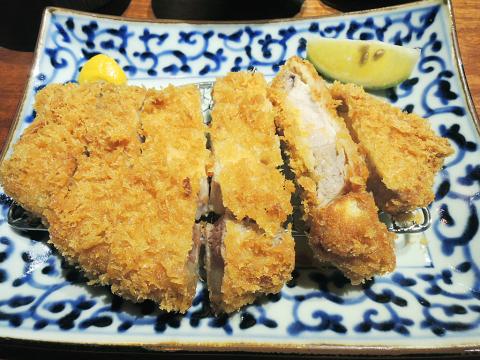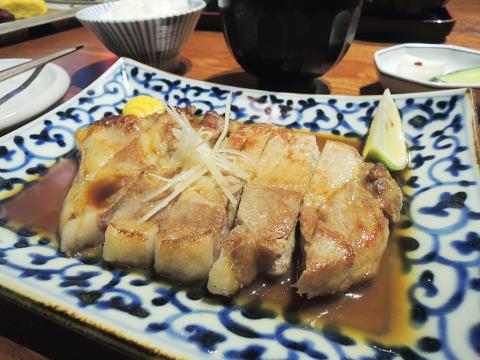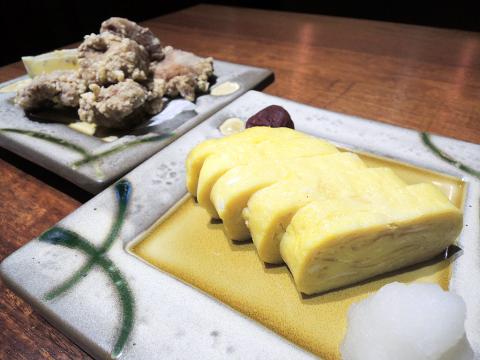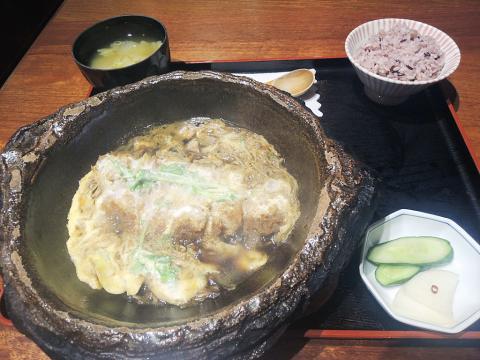Japan’s Wagokoro Tonkatsu Anzu Ginza, formerly known as Wagokoro Tonkatsu Anzu (“Ginza” was added after it partnered with Taiwan’s La Kaffa International Co [六角國際事業]), has earned a justified reputation for its tonkatsu, or deep-fried pork chops.
My friend and I visited the Zhongxiao branch (忠孝店), located inside the Bistro 98 building and a three-minute walk from the Zhongxiao Fuxing MRT Station (忠孝復興站), for dinner on a weekday a few weeks ago. We were promptly seated at a window table with views of the area’s bustling streets, which served as a nice contrast to the interior’s soft lighting and relaxing atmosphere.
The majority of the items on Anzu Ginza’s menu are set dishes that come with regular or purple rice, pickled vegetables, shredded lettuce and cabbage with purple perilla or pomelo sauce and miso soup. There are nine takeout options (NT$200 to NT$270) as well as pork and shrimp sandwiches (NT$130 each).

Photo: Eddy Chang, Taipei Times
We began with the six-egg Japanese egg roll (古早味玉子燒, NT$120). It was infused with light hints of soy sauce and was a nice balance between sweet and savory. This was followed up by the fried chicken pieces (炸雞塊, NT$100 for 6), slightly crispy on the outside and moist and juicy inside.
According to Anzu Ginza’s branch manager Irene Chiu (邱文萱), the restaurant’s cutlets are aged for seven days, nicely tenderizing them and giving them an intense flavor. The toro loin (TORO里肌肉套餐, NT$450/NT$370) is the restaurant’s signature dish. Though the Japanese word “toro” means fish belly, it is here synonymous with high quality. The large piece of breaded pork loin — which weighs 250g and is 3cm thick — is deep-fried until golden and crispy. As it contains more marbling than the other cuts on the menu, it’s juicier and more flavorsome. This is a must try for all pork chop-maniacs.
The pork loin pot (里肌豬排鍋膳套餐, NT$330/NT$250) is the restaurant’s most popular dish. Unlike conventional tonkatsu, this deep-fried pork loin arrives in a large pot and is topped with stir-fried onion slices and a simmered egg partially soaked in a broth. This creates a harmonious combination of flavors and textures between the bottom part of the pork loin, which is infused with the soup, and the top, which remains slightly crisp.

Photo: Eddy Chang, Taipei Times
If you are not a fan of deep-fried foods, the pan-fried pork loin with shredded ginger (生薑燒厚切里肌豬排, NT$350/NT$270) is a good option. The thickly-sliced meat is pan-fried and then stewed in a ginger and garlic sauce until the sauce is completely reduced. Its flavor remains robust, while being significantly less greasy than its deep-fried counterparts.
Other popular dishes include the Anzu special (杏子招牌特餐, NT$330/NT$250), including pork cutlets and shrimp, vegetable roll and steamed egg, and the grass shrimp and pork fillet (草蝦腰內豬排套餐, NT$350/NT$270).
Anzu Ginza has a minimum charge of NT$80 for all guests above 6 years old, and reservations are available at some branches. But the 90-minute time limit may be too short. Overall, Anzu Ginza is a satisfying dining experience, and its authentic Japanese cutlets are irresistible.

Photo: Eddy Chang, Taipei Times

Photo: Eddy Chang, Taipei Times

April 14 to April 20 In March 1947, Sising Katadrepan urged the government to drop the “high mountain people” (高山族) designation for Indigenous Taiwanese and refer to them as “Taiwan people” (台灣族). He considered the term derogatory, arguing that it made them sound like animals. The Taiwan Provincial Government agreed to stop using the term, stating that Indigenous Taiwanese suffered all sorts of discrimination and oppression under the Japanese and were forced to live in the mountains as outsiders to society. Now, under the new regime, they would be seen as equals, thus they should be henceforth

Last week, the the National Immigration Agency (NIA) told the legislature that more than 10,000 naturalized Taiwanese citizens from the People’s Republic of China (PRC) risked having their citizenship revoked if they failed to provide proof that they had renounced their Chinese household registration within the next three months. Renunciation is required under the Act Governing Relations Between the People of the Taiwan Area and the Mainland Area (臺灣地區與大陸地區人民關係條例), as amended in 2004, though it was only a legal requirement after 2000. Prior to that, it had been only an administrative requirement since the Nationality Act (國籍法) was established in

Three big changes have transformed the landscape of Taiwan’s local patronage factions: Increasing Democratic Progressive Party (DPP) involvement, rising new factions and the Chinese Nationalist Party’s (KMT) significantly weakened control. GREEN FACTIONS It is said that “south of the Zhuoshui River (濁水溪), there is no blue-green divide,” meaning that from Yunlin County south there is no difference between KMT and DPP politicians. This is not always true, but there is more than a grain of truth to it. Traditionally, DPP factions are viewed as national entities, with their primary function to secure plum positions in the party and government. This is not unusual

US President Donald Trump’s bid to take back control of the Panama Canal has put his counterpart Jose Raul Mulino in a difficult position and revived fears in the Central American country that US military bases will return. After Trump vowed to reclaim the interoceanic waterway from Chinese influence, US Defense Secretary Pete Hegseth signed an agreement with the Mulino administration last week for the US to deploy troops in areas adjacent to the canal. For more than two decades, after handing over control of the strategically vital waterway to Panama in 1999 and dismantling the bases that protected it, Washington has